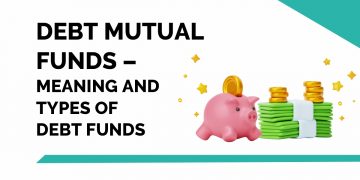A plan for retirement is often done through investing since it protects our assets from a decline in value,
which comes from inflation.
Because of inflation, the worth of a single rupee can deplete over time. This is known as the fall in the time value of money.
However, with investment, we can protect and grow the value of our assets, and ensure they can provide us with a stream of income when we retire.
Therefore, investing to protect our assets is essential, as it assists our plan for retirement.
In this blog, we will learn about some of the best pension tools to invest in .
| Table of Contents |
|---|
| Mutual Funds |
| National Pension System (NPS) |
| Voluntary Provident Fund (VPF) |
| Senior Citizens Savings Scheme (SCSS) |
| Reverse Mortgage |
1. Mutual Funds:
A mutual fund is a basket of professionally managed instruments, like stocks and commodities.
There are many types of long-term mutual funds, which can help investors build a retirement corpus.
When it comes to investing for retirement, an efficient strategy is to first invest in equity funds, which offer high risks and high returns.
As the investor grows closer to retirement, they can shift their investment from an equity to a debt mutual fund, preferably a long-duration fund.
This can be done with the help of a Systematic Transfer Plan, or STP.
An STP allows the investor to periodically transfer their investment from one fund to another over a period of time.
Learn basics of Mutual Fund with Mutual Fund Made Easy course by Market Experts
Advantages:
- A mutual fund is managed by fund managers, who expertly invest as per the needs of share-holders.
- Since the returns are market-linked, they can be equal to or even higher than the returns of government schemes like NPS and provident funds.
- Mutual funds are very flexible when it comes to catering to risk appetites and return requirements. Therefore, when you plan for retirement, mutual fund could be considered for investing.
2. National Pension System (NPS):
Another way to invest in equities or mutual funds, with the safety of government-based investing for retirement, is the National Pension System.
The NPS is a system where a subscriber can contribute to and create their own pension corpus.
Once they retire, they can withdraw a lump sum, and the remaining amount can be used as an annuity, to create a source of income after they retire.
You can register for the NPF here.
To begin contributing to an NPS account, one needs to have an NPS account with intermediaries known as a Point of Presence (PoP).
You can find the nearest PoP here.
Advantages:
- The NPS scheme is flexible, with multiple types of accounts to accommodate the needs of investors.
- Apart from the usual deductions allowed under section 80 of the IT Act, 1961, the lump-sum withdrawal and the annuity are both tax-exempt.
- One can also choose between an auto choice or an active choice. An auto choice invests on its own, whereas you can choose your investments and fund managers in the active choice scheme.
Apart from the stock market, the government and banks offer various investing tools as well which we can use when we plan for retirement.
3. Voluntary Provident Fund (VPF):
The VPF is a flexible pension plan that one can choose for their financial planning.
It is a completely voluntary contribution that a salaried employee can make towards a provident fund account, to create their own retirement corpus.
This contribution is above the 12% contribution that a salaried employee makes towards their Employee Provident Fund (EPF).
Advantages:
- The Voluntary Provident Fund scheme is an EEE scheme. It is exempt from tax on the contribution, principal and the interest. Its zero-taxation makes it beneficial for your plan for retirement.
- The VPF is fully managed by the Government of India, making it a very safe investment with a fixed return.
- To use VPF, one just needs to fill in a registration form for their VPF through their employer. If the job is changed, the amount can be transferred from one employer to another.
4. Senior Citizens Savings Scheme (SCSS):
An SCSS is a government scheme that involves deposits which mature after five years and provides a regular income in the form of interest during the time it is deposited.
This duration can be extended for an additional three years as well.
The deposit made will be paid on or after the expiry of five years, or after eight years, if the account is extended.
Also, the rate for the SCSS is the highest amongst all Indian small savings schemes.
Users of the scheme are allowed to only make lump-sum deposits in it.
Above the minimum amount, all deposits greater than ₹ 1000 have to be made in multiples of ₹ 1000.
Advantages:
- The scheme is government-backed and it offers a high saving rate compared to other schemes. This makes the scheme safe and profitable.
- It has a maturity of 5 years, which can be extended for three more years. This makes it flexible to an investor’s needs.
- The scheme can be applied for via all post offices or designated bank branches across India.
5. Reverse Mortgage:
A reverse mortgage is a special type of loan which is only available to home owners.
With this, a home owner can mortgage their owned house/property, and the bank pays them regular payments against the mortgage.
Unlike a regular mortgage, the home-owner does not need to repay anything to the bank.
Based on the demand for property, the conditions of the home, etc. the bank will disburse a loan amount, which can be at least 60% of the value of the property.
This amount can be given as a lump-sum or as regular payments, also known as reverse EMI.
Therefore, the returns of this scheme solely depend on the property and its quality.
Following the demise of the owner and their spouse, the bank will sell the house and settle the loan themselves.
Advantages:
- Senior citizens do not have to sell their properties to earn, instead they can use reverse mortgage to create a stream of income.
- The home-owner, if required, can also pay back the entire loan amount and take back ownership of their property, whenever they want.
- After the demise of the home owner and their spouse (if jointly owned), their legal heirs have the first right to settle the loan with the bank and take back ownership of the house.
Let us look at some of the basic features of these government-sponsored investment tools:
| Returns | Eligibility | Maximum/Minimum Contribution | |
| NPS | Returns are market-linked. | Indian citizens between the ages of 18 to 60 years. Even NRIs can apply for this scheme. | Minimum of ₹6,000 in a Tier-I account, and ₹3,000 in a Tier-II account every financial year. |
| VPF | 8.5% per annum, for FY 2019-2020. | Salaried person. | 100% of basic salary plus dearness allowance. |
| SCSS | 7.4% for the quarter of April-June. | Any individual resident above the age of 60 years. | Minimum amount of ₹1000, and maximum amount of ₹15,00,000. |
| Reverse Mortgage | Depends on the value of the house. | Any senior citizen above the age of 60, who is a residential home owner. | No maximum or minimum contribution. |
Bottomline
As we can see, there is a host of flexible products available when it comes to plan for retire
Suggested Read – Importance of Retirement Planning
However, one should first understand their retirement goals, and then compare such products to make sure their chosen products can satisfy their needs and make a proper plan for retirement.
Happy Learning!









